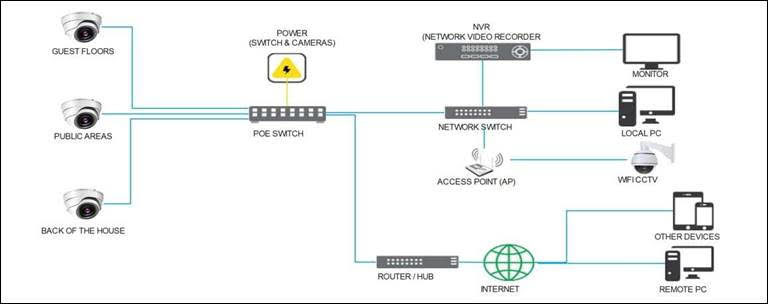CCTV

CCTV systems are an essential component of modern security infrastructure, providing a visible deterrent to potential intruders and a means of monitoring and recording activity in a specific area. By understanding the different types of CCTV cameras, benefits, and applications, individuals and organizations can make informed decisions about their security needs.
Benefits of CCTV Systems
Crime Deterrent: The presence of CCTV cameras can deter potential intruders and vandals.
Evidence Collection: CCTV footage can be used as evidence in investigations and court proceedings.
Real-Time Monitoring: CCTV systems allow for real-time monitoring of a specific area, enabling quick response to incidents.
Increased Safety: CCTV systems can help to identify potential safety hazards and prevent accidents.
Applications of CCTV Systems
Home Security: CCTV systems can be used to monitor homes and properties, providing an added layer of security.
Business Security: CCTV systems can be used to monitor businesses, including retail stores, offices, and warehouses.
Public Spaces: CCTV systems are often used in public spaces, such as parks, streets, and transportation hubs.
Industrial Settings: CCTV systems can be used in industrial settings, such as factories and construction sites.
Access Control

Access control systems are a critical component of security systems, ensuring that only authorized individuals can access specific areas, assets, or resources. By understanding the different types of access control systems, benefits, and applications, individuals and organizations can make informed decisions about their security needs.
What is Access Control
Access control refers to the process of granting or denying access to a specific area, asset, or resource based on a set of predefined rules, credentials, or permissions. Access control systems use various technologies, including electronic locks, biometric scanners, and card readers, to authenticate and authorize individuals.
Types of Access Control Systems
Physical Access Control: Physical access control systems use physical barriers, such as doors, gates, and fences, to control access to a specific area.
Electronic Access Control: Electronic access control systems use electronic devices, such as card readers, biometric scanners, and keypads, to authenticate and authorize individuals.
Logical Access Control: Logical access control systems use software and hardware to control access to digital resources, such as networks, databases, and applications.
Benefits of Access Control Systems
Improved Security: Access control systems provide an additional layer of security, ensuring that only authorized individuals can access specific areas or resources.
Increased Efficiency: Access control systems can automate the process of granting or denying access, reducing the need for manual intervention.
Reduced Liability: Access control systems can help reduce liability by preventing unauthorized access to sensitive areas or resources.
Enhanced Compliance: Access control systems can help organizations comply with regulatory requirements and industry standards.
Applications of Access Control Systems
Commercial Buildings: Access control systems are commonly used in commercial buildings, including offices, retail stores, and warehouses.
Industrial Settings: Access control systems are used in industrial settings, including factories, construction sites, and manufacturing facilities.
Government Facilities: Access control systems are used in government facilities, including federal buildings, courthouses, and military installations.
Residential Communities: Access control systems are used in residential communities, including gated communities and apartment complexes.
Key Features to Consider
Authentication Methods: The methods used to authenticate individuals, such as card readers, biometric scanners, and keypads. – add images for each
Authorization Rules: The rules used to determine who has access to specific areas or resources.
Access Levels: The different levels of access that can be granted to individuals, such as administrator, user, or guest.
Audit Trails: The ability to track and record access attempts, including successful and unsuccessful logins.